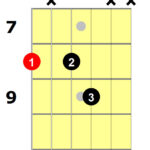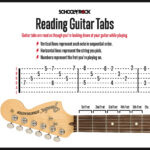The A6 Guitar Chord, often pronounced “A sixth,” is a captivating and versatile chord that adds a unique flavor to your guitar playing. Moving beyond the standard A major, the A6 introduces a dreamy, slightly jazzy, and even melancholic quality that can enrich various musical styles. From soulful ballads to upbeat pop tunes, the A6 chord offers a sonic depth that can elevate your music. You might recognize its distinctive sound in classics like “Isn’t She Lovely” by Stevie Wonder and modern hits alike.
In this guide, we’ll explore everything you need to know to play the A6 chord on guitar. We’ll cover various finger positions, including beginner-friendly versions and barre chord shapes, delve into common chord progressions where the A6 shines, and even suggest some drills to help you master it. Let’s unlock the potential of the A6 chord and bring a new dimension to your guitar skills.
Different Ways to Play the A6 Chord
Like many guitar chords, the A6 isn’t limited to just one finger position. Understanding different voicings allows you to use the A6 effectively in various musical contexts and positions on the fretboard. Let’s look at some of the most useful ways to play this chord.
The Most Common A6 Chord Shape
This is often the first A6 chord shape guitarists learn. It’s a barre chord based around the E major barre chord shape, moved up the neck.
[Refer to image from original article – “]
Finger Placement for the Common A6 Chord:
- Index Finger: Barre across all six strings at the 5th fret. Ensure each string rings clearly by applying even pressure across the fret.
- Ring Finger: Place your ring finger on the 7th fret of the 4th string (D string).
- Pinky Finger: Place your pinky finger on the 7th fret of the 3rd string (G string).
Strumming: Strum all six strings smoothly from the 6th (lowest E) string down to the 1st (highest E) string. Listen for a clear, resonant sound. If any strings buzz or are muted, adjust your finger pressure and placement.
An Easier Version of the A6 Chord for Beginners
If barre chords are still challenging, or you need a quicker, simpler A6 voicing, this version is perfect. It builds upon the open A major chord.
Finger Placement for the Easy A6 Chord:
- Start with the A Major Chord: Place your index finger on the 2nd fret of the 3rd string (G string), your middle finger on the 2nd fret of the 4th string (D string), and your ring finger on the 2nd fret of the 2nd string (B string).
- Add the Sixth: Extend your pinky finger to the 3rd fret of the 2nd string (B string). This added note is the 6th, transforming the A major into A6.
Strumming: Strum strings 5 (A string) down to 1 (high E string). You can omit the 6th string (low E) for this voicing, as it’s not essential to the A6 sound in this position.
This easier A6 is great for situations where you need quick chord changes and a less full, more melodic A6 sound.
The A6 Barre Chord in the ‘E Shape’
For a richer, fuller A6 sound, especially when playing higher up the neck, the ‘E shape’ barre chord is ideal. This is another movable barre chord shape, derived from the open E major chord.
Finger Placement for the A6 ‘E Shape’ Barre Chord:
- Index Finger: Barre across all six strings at the 5th fret. Again, ensure a clean barre by applying even pressure.
- Middle Finger: Place your middle finger on the 6th fret of the 3rd string (G string).
- Ring Finger: Place your ring finger on the 7th fret of the 5th string (A string).
- Pinky Finger: Place your pinky finger on the 7th fret of the 4th string (D string).
Strumming: Strum all six strings. This barre chord voicing provides a powerful and resonant A6 sound, suitable for lead guitar work or rhythm playing that requires a strong presence.
Common Chord Progressions Featuring the A6
The A6 chord’s distinctive sound lends itself beautifully to certain chord progressions, often creating a feeling of sophistication and emotional depth. Here are some popular progressions where the A6 chord can be effectively used (using Roman numeral notation where vi represents Am in the key of C, but becomes A6 in the key of C if we are talking about the relative minor):
- vi – IV – I – V (A6 – F – C – G in the key of C): This progression is incredibly common and versatile, found in countless songs. The A6 adds a unique twist compared to a standard Am in this sequence. Think of songs like “All of Me” by John Legend and “Let It Be” by The Beatles, although they may not explicitly use A6, the feeling is similar and A6 can be substituted effectively to add flavor.
- vi – V – IV – V (A6 – G – F – G in the key of C): This progression creates a slightly more cyclical and less resolved feeling than the previous one. The movement from A6 to G is smooth and the return to G after F keeps the harmonic tension interesting.
- vi – iii – IV – V (A6 – Em – F – G in the key of C): Substituting the ii chord (Dm) with the iii chord (Em) adds a brighter, more uplifting quality to the progression, even with the melancholic A6 at the start.
- vi – ii – V – I (A6 – Dm – G – C in the key of C): This classic jazz and pop progression provides a strong sense of resolution at the end. The A6 functions as a rich minor-type chord leading into the ii-V-I cadence.
- vi – IV – V – iii (A6 – F – G – Em in the key of C): This progression is a variation of the first, ending on the iii chord (Em) instead of the I chord (C), creating a slightly less conclusive and more open-ended feel.
Experiment with these progressions and listen to how the A6 chord changes the emotional character compared to using a standard Am or A minor 7th.
Drills to Master the A6 Chord
Consistent practice is key to making the A6 chord sound smooth and become second nature. Here are some effective drills:
- Individual Note Practice: Play each note of the A6 chord (A, C#, E, and F#) individually. Focus on clean, clear tones for each note. This helps train your ear to recognize the components of the chord and ensures each finger is contributing correctly.
- Chord Transition Practice: Practice smoothly transitioning between the A6 chord and other common chords you know, such as A major, D major, E major, or chords within the progressions listed above (F, C, G, Em, Dm). Start slowly, focusing on accuracy, and gradually increase your speed as you become more comfortable.
- Rhythmic Strumming: Once you can form the A6 chord cleanly, practice strumming it in various rhythms. Experiment with quarter notes, eighth notes, sixteenth notes, and different strumming patterns. This will improve your timing and muscle memory for playing the chord in different musical contexts.
- Arpeggiated Practice: Play the notes of the A6 chord as an arpeggio (one note at a time, in sequence). Ascend and descend through the arpeggio. This helps you internalize the chord shape and strengthens finger independence.
Songs That Feature the A6 Chord
Learning songs that use the A6 chord is a fun and practical way to solidify your understanding and technique. Here are 10 popular songs that incorporate the A6 chord:
- Dreams by Fleetwood Mac (F, G, A6) – A classic with a dreamy, ethereal feel, perfectly complemented by the A6.
- Fast Car by Tracy Chapman (G, D, C, Em7, D/F#, A6) – The A6 adds to the emotional depth of this poignant song.
- Landslide by Fleetwood Mac (C, G, Am7, G/B, A6) – Another Fleetwood Mac gem where the A6 contributes to the song’s gentle and introspective mood.
- Wonderwall by Oasis (Em7, G, D, A6) – A stadium anthem that uses the A6 to create a sense of longing and anthemic release.
- Hey There Delilah by Plain White T’s (D, F#m, A6, Bm) – The A6 adds a sweet, slightly melancholic touch to this acoustic pop hit.
- Riptide by Vance Joy (Am, G, C, A6) – The A6 fits perfectly within the ukulele-esque vibe of this catchy tune.
- Good Riddance (Time of Your Life) by Green Day (G, C, D, Em7, A6) – Even in a Green Day song, the A6 adds a touch of sentimentality and reflection.
- Hey Soul Sister by Train (C, G, Am7, F, A6) – The A6 contributes to the upbeat, feel-good nature of this pop-rock song.
- I’m Yours by Jason Mraz (C, G, Am7, F, A6) – A mellow, feel-good track where the A6 enhances the laid-back vibe.
- Sunny Came Home by Shawn Colvin (Am7, Dsus2, Cmaj7, Fmaj7, A6) – The A6 contributes to the sophisticated and slightly jazzy harmonic palette of this song.
As you learn these songs, pay attention to how the A6 chord is used in context. Notice its role in the chord progressions and how it contributes to the overall feeling of each song.
When to Seek Guidance from a Guitar Teacher
While online resources are invaluable, personalized feedback from a guitar teacher can significantly accelerate your learning. If you are struggling with barre chords, chord transitions, or understanding music theory concepts related to chords like the A6, consider seeking guidance from a qualified guitar instructor.
A teacher can:
- Provide tailored instruction: Address your specific challenges and learning style.
- Offer real-time feedback: Correct your technique and prevent bad habits from forming.
- Accelerate your progress: Guide you through structured learning paths and keep you motivated.
Platforms like Til offer access to expert guitar teachers online, providing flexible scheduling, secure lessons, and personalized guidance from the comfort of your home. Investing in even a few lessons can provide a significant boost to your guitar playing journey.
Conclusion
The A6 guitar chord is a rewarding addition to any guitarist’s chord vocabulary. Its unique sound opens up new musical possibilities and adds depth to your playing. By mastering the different positions, practicing chord progressions, and learning songs that feature the A6, you’ll unlock its full potential and enrich your musical expression on the guitar. Keep practicing, and enjoy the journey of exploring this beautiful chord!


